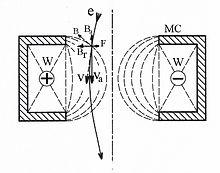
Electron optics is the branch of physics that studies the trajectories of electrons along electromagnetic fields. The term optics is used because magnetic and electrostatic lenses act upon a charged particle beam similarly to optical lenses upon a light beam.
Electron optics calculations are crucial for the design of electron microscopes and particle accelerators. In the paraxial approximation, trajectory calculations can be carried out using ray transfer matrix analysis.

Electron properties
editElectrons are charged particles (point charges with rest mass) with spin 1/2 (hence they are fermions). Electrons can be accelerated by suitable electric (or magnetic) fields, thereby acquiring kinetic energy. Given sufficient voltage, the electron can be accelerated sufficiently fast to exhibit measurable relativistic effects. According to wave particle duality, electrons can also be considered as matter waves with properties such as wavelength, phase and amplitude.
Geometric electron optics
editMagnetic fields
editElectrons interact with magnetic fields according to the second term of the Lorentz force: a cross product between the magnetic field and the electron velocity. In an infinite uniform field this results in a circular motion of the electron around the field direction with a radius given by:
where r is the orbit radius, m is the mass of an electron, is the component of the electron velocity perpendicular to the field, e is the electron charge and B is the magnitude of the applied magnetic field. Electrons that have a velocity component parallel to the magnetic field will proceed along helical trajectories.
Electric fields
editIn the case of an applied electrostatic field, an electron will deflect towards the positive gradient of the field. Notably, this crossing of electrostatic field lines means that electrons, as they move through electrostatic fields change the magnitude of their velocity, whereas in magnetic fields, only the velocity direction is modified.
As electrons can exhibit non-particle (wave-like) effects such as diffraction, a full analysis of electron paths can be obtained by solving Maxwell's equation—however in many situations, the particle interpretation may provide a sufficient approximation with great reduction in complexity.
One further property of electrons is that they interact strongly with matter as they are sensitive to not only the nucleus, but also the matter's electron charge cloud. Therefore, electrons require vacuum to propagate any reasonable distance, such as would be desirable in electron optic system.
Penetration in vacuum is dictated by mean free path, a measure of the probability of collision between electrons and matter, approximate values for which can be derived from Poisson statistics.
Quantum theory
editAlthough not very common, it is also possible to derive effects of magnetic structures to charged particles starting from the Dirac equation.[1]
See also
editFurther reading
edit- Hawkes, P. W. & Kasper, E. (1994). Principles of Electron Optics. Academic Press. ISBN 9780080984162.
- Pozzi, G. (2016). Particles and Waves in Electron Optics and Microscopy. Academic Press. ISBN 9780128048146.
References
edit- ^ Jagannathan, R.; Simon, R.; Sudarshan, E. C. G.; Mukunda, N. (1989). "Quantum theory of magnetic electron lenses based on the Dirac equation". Physics Letters A. 134 (8–9): 457. Bibcode:1989PhLA..134..457J. doi:10.1016/0375-9601(89)90685-3.
